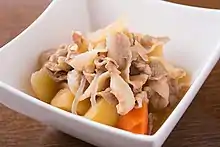Nikujaga
Nikujaga (肉じゃが, lit. 'meat [and] potatoes'[lower-alpha 1]) is a Japanese dish of meat, potatoes and onion stewed in sweetened soy sauce and mirin, sometimes with ito konnyaku and vegetables.[1] Nikujaga is an example of yōshoku (Western-influenced Japanese cuisine). Generally, potatoes make up the bulk of the dish, with meat mostly serving as a source of flavor. It is usually boiled until most of the liquid has been reduced.[2] Thinly sliced beef is the most common meat used, although minced or ground beef is also popular.[3] Pork is often used instead of beef in eastern Japan.[3]
.jpg.webp) | |
| Place of origin | Japan |
|---|---|
| Main ingredients | Meat (sliced or ground beef, or pork), potatoes, onion, sweetened soy sauce and mirin |
Nikujaga is a common home-cooked winter dish, served with a bowl of white rice and miso soup. It is also sometimes seen in izakayas.
History

Nikujaga was invented by chefs of the Imperial Japanese Navy in the late 19th century.[1]
One story is that in 1895 Tōgō Heihachirō ordered naval cooks to create a version of the beef stews as served in the British Royal Navy. Tōgō was stationed in Maizuru, Kyoto, which established this Imperial Japanese Navy base as the birthplace of nikujaga.[4]
The municipal government of Kure, Hiroshima, responded in 1898 with a competing claim that Tōgō commissioned the dish while serving as chief of staff of the Kure naval base.[5]
See also
Footnotes
References
- "肉ジャガ" [Nikujaga]. Dijitaru Daijisen (in Japanese). Tokyo: Shogakukan. 2012. OCLC 56431036. Archived from the original on August 25, 2007. Retrieved 2012-08-27.
- "肉じゃがのレシピ|キユーピー3分クッキング". 日本テレビ (in Japanese). Retrieved 2015-10-31.
- "★激論★ 肉じゃがといえば、豚か、牛か! それとも何か!? | クックパッド". クックパッド. Retrieved 2015-10-31.
- Asami Nagai, "Cities claim signature dishes cooked up in navy galleys" Archived 2012-02-22 at the Wayback Machine, Yomiuri Shimbun, 5 February 2000. Retrieved on 2009-03-24. "As it happens, Togo had studied naval science in Britain from 1871 to 1878, so Shimizu reasoned he must have eaten beef stew occasionally. 'We concocted a story that Togo ordered the cooks to fix something similar to beef stew,' he said." In fact, beef stews were already known before that time in Japan.
- Asami Nagai, "Cities claim signature dishes cooked up in navy galleys" Archived 2012-02-22 at the Wayback Machine, Yomiuri Shimbun, 5 February 2000. Retrieved on 2009-03-24. "City assembly members believed Togo was stationed at the Kure naval base from May 1890 to December 1891, and theorized that he likely introduced nikujaga to the navy diet at that time to prevent vitamin B deficiency."